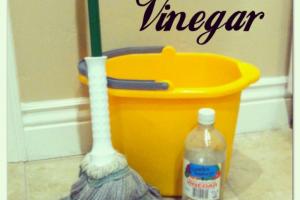Ultimate Guide to Cleaning Tile Floors with Vinegar: Tips and Tricks

-
Quick Links:
- 1. Why Choose Vinegar for Cleaning Tile Floors?
- 2. Understanding Different Types of Tile Floors
- 3. Preparing Your Tile Floors for Cleaning
- 4. Step-by-Step Guide to Cleaning Tile Floors with Vinegar
- 5. Additional Tips for Maintaining Tile Floors
- 6. Expert Insights and Case Studies
- 7. FAQs
1. Why Choose Vinegar for Cleaning Tile Floors?
Vinegar is a natural cleaning agent that is both effective and safe for many types of surfaces, including tile floors. Its acidic nature helps dissolve grime, dirt, and stains without the harsh chemicals found in commercial cleaners. Here are some benefits of using vinegar:
- Eco-Friendly: Vinegar is a biodegradable product that poses minimal risk to the environment.
- Cost-Effective: Vinegar is inexpensive and can be used in various cleaning applications.
- Non-Toxic: It is safe for households with children and pets.
- Antimicrobial Properties: Vinegar can help reduce bacteria and germs on surfaces.
2. Understanding Different Types of Tile Floors
Before cleaning your tile floors, it's essential to know what type of tile you have. Different tiles may require different cleaning methods. Here are the most common types:
- Ceramic Tiles: Durable and water-resistant, they are easy to clean with vinegar.
- Porcelain Tiles: Similar to ceramic but denser; vinegar is generally safe for these tiles too.
- Natural Stone Tiles: Limestone, marble, and granite can be sensitive to acidic cleaners, including vinegar.
- Vinyl Tiles: While vinegar can clean vinyl, it’s essential to ensure it’s diluted properly.
3. Preparing Your Tile Floors for Cleaning
Proper preparation can make the cleaning process more effective. Follow these steps:
- Clear the Area: Remove all furniture and items from the floor.
- Sweep or Vacuum: Remove loose dirt and debris to prevent scratching during cleaning.
- Check for Stains: Identify any tough stains that may need special attention.
4. Step-by-Step Guide to Cleaning Tile Floors with Vinegar
Follow these detailed steps to clean your tile floors effectively:
Step 1: Gather Your Supplies
- White distilled vinegar
- Warm water
- Bucket
- Mop or soft-bristle brush
- Microfiber cloths
- Optional: Essential oils (for fragrance)
Step 2: Mix the Cleaning Solution
Combine equal parts of vinegar and warm water in a bucket. For a stronger solution, you can increase the vinegar ratio, but be cautious with sensitive tiles.
Step 3: Mop the Floor
Dip your mop into the solution, wring it out, and start mopping the floor. Work in small sections, and make sure to rinse the mop frequently to avoid spreading dirt.
Step 4: Allow the Solution to Sit
Let the vinegar solution sit for 5-10 minutes for tough stains. This will help break down the grime.
Step 5: Scrub Stains
For stubborn spots, use a soft-bristle brush or a microfiber cloth to gently scrub the area.
Step 6: Rinse the Floor
After cleaning, mop the floor again with clean water to remove any vinegar residue. This is especially important for sensitive tiles.
Step 7: Dry the Floor
Use a dry microfiber cloth or allow the floor to air dry. Ensure the floor is completely dry to avoid slips.
5. Additional Tips for Maintaining Tile Floors
To keep your tile floors looking pristine, consider the following maintenance tips:
- Regularly sweep or vacuum to prevent dirt buildup.
- Use mats at entryways to minimize dirt tracked onto the tiles.
- Consider sealing natural stone tiles to protect against stains.
- Perform deep cleanings every few months using the vinegar method.
6. Expert Insights and Case Studies
According to a study conducted by the National Cleaning Institute, natural cleaning products like vinegar can effectively reduce harmful bacteria on surfaces, promoting a healthier home environment. Many cleaning experts advocate for vinegar as a primary cleaning agent due to its versatility and safety. For instance, a case study from EcoWatch highlighted how families who switched to natural cleaners reported improved indoor air quality.
FAQs
1. Is vinegar safe for all types of tile floors?
Vinegar is safe for most tile floors, but avoid using it on natural stone tiles as it can damage the surface.
2. How often should I clean my tile floors with vinegar?
It’s recommended to clean your tile floors with vinegar every month, or more frequently in high-traffic areas.
3. Can I add essential oils to the vinegar cleaning solution?
Yes, adding a few drops of essential oils can help mask the vinegar smell and provide a pleasant fragrance.
4. What if my tile floors have a wax coating?
Do not use vinegar on waxed floors as it can strip the wax. Instead, use a cleaner specifically designed for waxed surfaces.
5. Can I use apple cider vinegar instead of white vinegar?
While apple cider vinegar can work, it may leave a sticky residue. White vinegar is preferred for cleaning tile floors.
6. How do I remove tough stains from tile floors?
For tough stains, let the vinegar solution sit longer before scrubbing, or consider using baking soda in combination with vinegar for added abrasiveness.
7. What should I do if my floors feel slippery after cleaning?
If your floors feel slippery, it may be due to vinegar residue. Mop with clean water to remove any leftover solution.
8. Is vinegar effective against mold and mildew?
Yes, vinegar has antifungal properties that can help reduce mold and mildew on tile surfaces.
9. Can I use vinegar in a steam mop?
It’s not recommended to use vinegar in steam mops, as it can damage the machine. Always check the manufacturer’s instructions.
10. What is the best way to maintain the shine of my tile floors?
Regular cleaning with vinegar and ensuring floors are sealed (if applicable) can help maintain their shine.